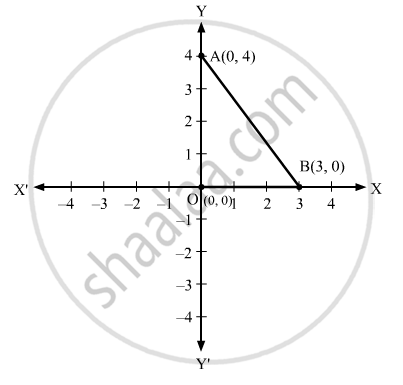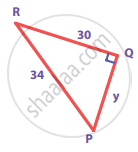Advertisements
Advertisements
Question
The perimeter of a triangle with vertices (0, 4), (0, 0) and (3, 0) is
(A)\[7 + \sqrt{5}\]
(B) 5
(C) 10
(D) 12
Solution
Let us plot these coordinates, i.e. O(0, 0), A(0, 4) and B(3, 0), on the Cartesian plane.

We can observe that triangle AOB is a right-angled triangle with OB = 3 units and OA = 4 units.
Now, AB2 = OA2 + OB2 (By Pythagoras theorem)
⇒ AB2 = (42 + 32) sq. units
= (16 + 9) sq. units
= 25 sq. units
⇒ AB = 5 units
Perimeter of ∆AOB = OA + AB + BO
= (3 + 5 + 4) units
= 12 units
Hence, the correct option is D.
APPEARS IN
RELATED QUESTIONS
The points A(4, 7), B(p, 3) and C(7, 3) are the vertices of a right traingle ,right-angled at B. Find the values of p.
In the given figure, ABC is a triangle in which ∠ABC < 90° and AD ⊥ BC. Prove that AC2 = AB2 + BC2 − 2BC.BD.

Find the length diagonal of a rectangle whose length is 35 cm and breadth is 12 cm.
In triangle ABC, AB = AC and BD is perpendicular to AC.
Prove that: BD2 - CD2 = 2CD × AD
Choose the correct alternative:
In right-angled triangle PQR, if hypotenuse PR = 12 and PQ = 6, then what is the measure of ∠P?
Triangle ABC is right-angled at vertex A. Calculate the length of BC, if AB = 18 cm and AC = 24 cm.
In a triangle ABC, AC > AB, D is the midpoint BC, and AE ⊥ BC. Prove that: AC2 - AB2 = 2BC x ED
In a triangle ABC right angled at C, P and Q are points of sides CA and CB respectively, which divide these sides the ratio 2 : 1.
Prove that: 9AQ2 = 9AC2 + 4BC2
The perpendicular PS on the base QR of a ∆PQR intersects QR at S, such that QS = 3 SR. Prove that 2PQ2 = 2PR2 + QR2
Find the unknown side in the following triangles
